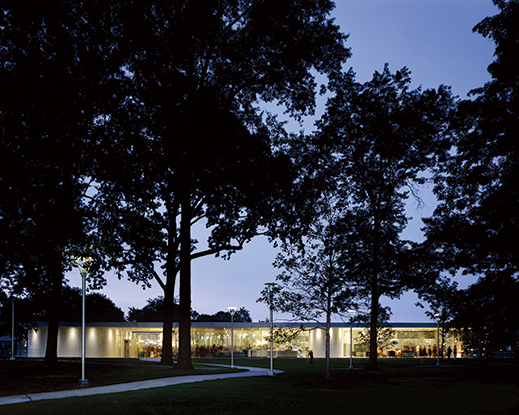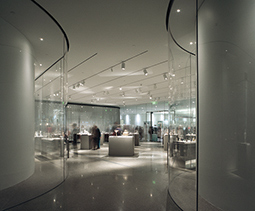 |
|
Evening view of the Glass Pavilion, Toledo Museum of Art. Photograph by floto+warner |
While the outside world's fascination with Japanese culture still tends to veer between the poles of traditional (ukiyo-e, ikebana, Zen) and pop (manga, anime, J-Pop), arguably the most groundbreaking work now coming out of Japan is in the field of architecture. Far from contenting themselves with appropriations or reworkings of styles that originated in the West, Japanese architects are the innovative leaders of the global pack these days, and the structures they design have begun to show up in unexpected places.
On a recent visit to the midwestern U.S. city of Toledo, Ohio, where my family lived for many years, I discovered that the most famous building in town is one designed by a Japanese architectural team. The Glass Pavilion at the Toledo Museum of Art is the creation of SANAA, Ltd., the duo of Kazuyo Sejima and Ryue Nishizawa. Today SANAA may be a household name among architecture buffs worldwide, but a decade ago their work was not so well known outside Japan. Completed in 2006, the Glass Pavilion was their first U.S. commission. Since then they have gone on to design such big-ticket showpieces as the New Museum of Contemporary Art in New York, the Louvre at Lens in France, and the Rolex Learning Center in Lausanne, Switzerland.
 |
|
 |
|
|
|
A corner of the Glass Pavilion. Photograph by floto+warner |
|
One of the galleries containing the Toledo Museum's collection of glass works from around the world. Photograph by floto+warner |
Anyone who has seen SANAA's buildings knows that glass is their forte, almost to the point of cliché. Those unfamiliar with Toledo or its art museum (consistently voted one of the best in the country) might be forgiven for assuming that the Glass Pavilion is named for the material it is made of. In fact, it houses one of the largest collections (over 5,000 items) of glass in the world -- a perfect match, as the museum evidently realized, with SANAA's predilections.
Why glass in Toledo? Well, the city calls itself the Glass Capital of the World for good reason: this is where America's glass industry has been centered since the late 19th century. It was glass money that built the Museum of Art in 1901 and enabled it to amass an excellent collection not only of glass, but Old Masters, Impressionists, and more. More recently, the studio glass movement, which paved the way for artists to work with blown glass in their own workshops, was born here in the 1960s.
|
| View from the Glass Pavilion interior looking out to the greensward beyond. |
As for SANAA, they have been around since 1995, when Sejima and Nishizawa first joined forces. Though they began working on overseas projects in the late 1990s, their global visibility took a quantum leap when they won the Golden Lion award at the 2004 Venice Architecture Biennale for their design of the 21st Century Museum of Contemporary Art in Kanazawa. In 2010 SANAA received the Pritzker Prize for "architecture that is simultaneously delicate and powerful, precise and fluid, ingenious but not overly or overtly clever." That same year Sejima was appointed director of the 2010 Venice Architecture Biennale. Views of SANAA's projects can be seen here and here.
|
 |
|
|
|
A massive glass chandelier by Dale Chihuly dominates the front entrance of the Pavilion.
|
The Glass Pavilion bears certain similarities to the 21st Century Museum in Kanazawa. Both are low-lying, single-story structures, all in white with continuous glass-curtain walls around the perimeter. Where the Kanazawa building is circular, the Pavilion is a square with rounded corners. Indeed, the Pavilion exterior is anything but overwhelming, though it looks lovely when lit up at night. What truly shines, however, is the interior. Nearly all of the inside paneling is glass as well (unlike the 21st Century Museum, most of whose galleries are divided by opaque white walls), producing a labyrinthine, funny-mirror effect I have never encountered in a building not located in an amusement park. It takes a while to adjust and relax, the initial impulse of the first-time visitor being fear of walking straight into a glass wall.
The museum has put this novel design to good use, positioning its glass exhibits in galleries of various sizes that showcase the works on display as if one were wandering through a gigantic lightbox. While the larger rooms are devoted to the museum's vast array of glass objects of all sizes, functions, and eras, it is the smaller spaces, nestled between the undulating, transparent partitions, that draw the eye to the contemporary sculptures arranged therein. Two standouts are the German artist Josepha Gasch-Muche's glittering pyramid of LCD shards, and a series of large orbs by the American artist Dale Chihuly -- inspired, we are told, by the glass floats used by Japanese fishermen. Chihuly also contributed the monumental chandelier that hangs in the Pavilion foyer.
|
| Glass artists working at the furnaces in the Hot Shop, a studio in the center of the Glass Pavilion. |
Nearly as fascinating as the exhibits is the Hot Shop, a glassworking studio smack in the midst of the galleries, where the museum keeps its glassblowing furnaces going 24-7. Visitors can peer right through the walls and observe artists extracting molten globs from these glowing cauldrons. Among the unseen wonders of the Pavilion are a heating system that diverts most of the hot air from the furnaces to the outside while retaining enough to warm the rest of the space; a ceiling that contains much of the wiring normally placed in walls, yet is light enough not to crush the glass panels it rides upon; and a roof that appears flat, but actually consists of tiny inverted pyramids that enable it to withstand the region's sometimes heavy snows.
Surrounded by the broad lawns of the museum grounds and set back some distance from the street, the Glass Pavilion's low-slung design makes it an almost disappointingly unassuming presence from the outside. The trade-off is that its park-like setting allows plenty of soothing green light into the interior, which might otherwise feel a tad austere and monochromatic.
Lack of space may not be a concern in a sprawling American city like Toledo, but SANAA's home turf of Tokyo is a different story. Here a study in contrasts is provided by Sejima's brand-new Shibaura House, a boxy multistory structure squeezed onto a cramped downtown street corner. Yet by adhering to the same fundamental concepts SANAA applied in Toledo, Sejima has managed to inject both light and whimsy into what could have been a very prosaic building. Here again the façade is all glass, but what attracts the eye are the diagonal struts that cut across the square panes, and the curving walls and staircases that lurk just behind them. In many ways, the architect's success in pursuing her vision within the confines of the Shibaura House lot is more impressive than the less rigorous, almost languid approach taken by SANAA with more generous spaces like that of the Toledo Museum. Still, there's no denying that Sejima and Nishizawa have come up with an identifiable style -- glassy, curvy, floaty, white -- that works just about anywhere you use it.
Images courtesy of the Toledo Museum of Art. Photography by Alan Gleason unless otherwise indicated.
|
|
|
|
 |
Alan Gleason
Alan Gleason is a translator, editor and writer based in Tokyo, where he has lived for 28 years. In addition to writing about the Japanese art scene he has edited and translated works on Japanese theater (from kabuki to the avant-garde) and music (both traditional and contemporary). |
|
|
|